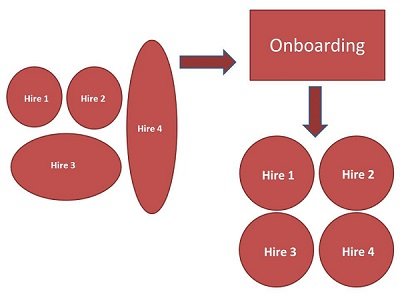ATD Blog
We Personalize Everything—Why Not Onboarding?
Thu Nov 15 2018

Bookmark
We once believed that training and onboarding would be more efficient because we could design and deliver the same experience for everyone. There was time when we talked about efficiency of scale or used the dreaded word, standardization. Build it once and deliver the same thing a thousand times, week after week. Good onboarding for everyone, everywhere.
But we don’t live in that type of world any longer.
The world has changed, and companies are taking advantage of the opportunity to build and sell unique experiences. Established brands like Vans are migrating to mass customization by building digital tools that allow you to customize your own shoes. Coca-Cola now offers personalized bottles through their “Share a Coke” campaign and custom drinks dispensed through a Coca-Cola Freestyle machine. Consumers are choosing personalization and customization.
Data from Forrester indicates that 77 percent of consumers have chosen, recommended, or paid more for a brand that provides a personalized experience.
So why do we accept one-size-fits-all with our onboarding?
Organizations need to consider building personalized onboarding and learning programs to improve efficiency and increase proficiency.
Traditional onboarding can be very inefficient because it can waste time and decrease engagement. Let’s take a look at a scenario from healthcare. A nurse, a nurse practitioner, and a healthcare administrator walk into a classroom on their first day on the job. The next part is quite comical: We complete a one-week blended learning experience sharing with each of them the same content and experience.
And yet, the nurse practitioner is a new graduate who just finished an accelerated program; he will be working in the radiology unit. Another new hire is actually an experienced nurse with 35 years of experience in the psychiatric unit. She has excellent knowledge of and experience with de-escalation and Joint Commission standards . . . but when you put her in front of a computer, you might as well have asked her to fly a spaceship. The healthcare administrator was a critical hire, and while she has nursing experience, her main function since leaving a consulting firm specializing in revenue cycle has been working on operational excellence and cash flow for her areas. She has been on the job for four weeks waiting until the next orientation program started. We place all three of these employees in the same room with the exact same training, and then we expect them to be able to perform their unique jobs well.
The diagram below illustrates the ideal state:

As with the diagram, the inputs (new hires) being received will always be varied. Then, there is the box of what happens during onboarding. At the end of it all, we expect the outputs to be standardized with employees ready to perform their job.
To achieve personalized onboarding, initial assessments can be used to better understand an employee’s areas of excellence, areas of potential growth, and areas that need to be developed to ensure job readiness. Identifying individual strengths and learning gaps particularly in nurses in the Med/Surg, ICU, Labor and Delivery, and ER units has shown a cost savings over $5,000 over three sample nurses with varying experience. This cost reduction is primarily from the reduced seat time in onboarding for more experienced nurses. For example, instead of the typical eight-week onboarding, some nurses were able to reduce their onboarding curriculum to five weeks.
Additionally, through the evolution of learning content management systems, content can be segmented into reusable learning segments of 2-8 minutes so that each learner’s digital onboarding experience can be tailored and prioritized. In fact, after the initial assessments, content can be grouped into required, recommended, and optional segments based on the results. Some organizations direct learners to complete both required and recommended segments, while others opt to mandate only the required content.
And let’s not forget about the data: As more new hires complete the initial assessment and potentially a later assessment at the end of onboarding, critical data can be gathered about department strengths and opportunities. This information can further inform additional skills desired in open roles. Another benefit of the growing data set is the ability to benchmark performance on key skills against peers and national samples. Data can also show the efficiency and effectiveness of personalized onboarding.
Onboarding is critical to staff’s future productivity and retention. SHRM found that strong onboarding programs result in 69 percent of employees being more likely to stay with an organization for at least three years.
To learn more, come to ATD TechKnowledge where we are presenting “Accelerate Proficiency With Personalized Learning Paths.”





